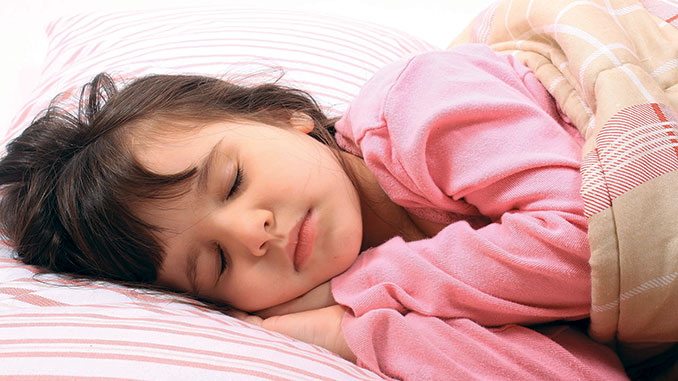
Get your kids slumbering soundly again
Published: April 20, 2021
By: Malia Jacobson
First, the good news: Thanks to social distancing and reduced travel, fewer children experienced ear infections, colds, and other minor illnesses over the past year, says Maida Chen, MD. Because these illnesses routinely disrupt slumber for babies, toddlers, and young children, families may have fewer illness-related sleep complaints.
That doesn’t mean everyone is sleeping soundly. Instead, more parents are reporting sleep regressions: babies and toddlers skipping or dropping naps, suddenly waking at night, or taking ages to fall asleep at bedtime. With family schedules still in flux, daily and sleep routines may be shifting, says Chen. Here’s how to cope.
Redefining regression
The term “sleep regression” describes a temporary but troubling return of an undesirable sleep behavior that a parent or caregiver assumed the child had outgrown, including sudden night awakenings, tears at bedtime, or waking at 4 a.m. Although sleep regressions are real, whether or not they’re a problem may be a matter of perception, says Chen.
About half the time, a sleep regression is developmentally appropriate; it’s normal for babies to wake more often after they’ve acquired a new skill, like learning to roll over or stand. “A sleep regression is really just a change in sleep that’s perceived as undesirable by a caregiver,” says Chen. “It’s simply a misalignment with our expectations of how a baby should be sleeping compared to what’s happening with their sleep.”
While sleep regressions can happen at any time, they’re common around 4, 9, 12, 18 and 24 months of age and can coincide with developmental milestones. One study found that learning to crawl temporarily disrupts nighttime sleep between 5 and 11 months of age. Another study found that nap transitions in toddlerhood can shift melatonin production and delay bedtime.
Sleep regressions can stretch anywhere from a few days to a few weeks or longer, and often involving overtired, fussy behavior during the day and long, irritable stretches of light sleep or crying at night. It’s no wonder that parents want to rush through these regressions and get sleep back on track, STAT.
Why regressions seem worse this year
Childhood sleep disruptions have seemed worse during COVID, despite fewer illness-related sleep complaints from parents, says Chen. But the changes may have more to do with stress than actual sleep problems. “The issue is more highlighted now because we’re spending more time at home and traveling less, and parents have much less time away from their kids,” she says. “When you rely on your toddler’s nap or bedtime so that you can work or have a break, you’re going to be more upset when those regressions happen.”
But it’s also true that there may be genuine disruptions in sleep patterns, like fewer naps or later bedtimes, for a couple of reasons. Spending more time at home might mean that a baby is sleeping later in the morning or taking a longer afternoon nap, factors that can cause a later bedtime or nighttime awakenings. As spring turns to summer, families are also battling the normal, seasonal early sunrises and late sunsets that disrupt melatonin production and delay bedtimes.
How to help
- First, take inventory of your child’s supposed sleep problems, recommends Chen. “Parents should really do a gut check about what their child is experiencing in terms of sleep, and how big of a problem it really is for the child and the family. Is your child really being affected adversely from a developmental standpoint or is it really just the stress of upholding what life is supposed to look like?”
- Determine your family sleep priorities. If you’re operating in survival mode and just need to nab enough shut-eye to get through the next day, don’t waste a moment worrying about bringing your toddler into bed with you if it will help everyone get more sleep, says Chen.
On the other hand, if keeping your child’s daily routine on track helps keep stress at bay, don’t feel guilty about prioritizing a consistent sleep schedule. “If the family thrives on routine and survival is not the main concern, then this can be a good time to teach the baby or toddler self-soothing skills.” That could mean allowing your baby some extra time to fall asleep unaided or encouraging your toddler to play alone if they wake too early or aren’t taking a nap.
- Build in regular times for movement, especially in the morning, when light exposure helps regulate sleep patterns and pave the way for a smoother bedtime. Aim for 10 minutes of outdoor time within the first hour of waking up; try a morning walk around the block or a game of hopscotch in the driveway. Investing in cheap blackout blinds from a big-box store can also help keep sleep routines intact during the bright spring and summer months, says Chen.
- Limit screen time, especially in the final hour or two before bed. “This can be a time to establish family routines that support rest, like taking time at night to unplug as a family and relax,” she notes. “Parents can model healthy habits like taking a break from phones and screens at night.”
It’s normal to feel stressed when things seem to fall apart, including your child’s sleep routine, says Chen. But like everything else in babyhood, the change is temporary; children with healthy sleep patterns will nearly always get back on track after a developmental milestone, life change, or seasonal disruption passes. “Right now, what parents need most is to give themselves grace,” says Chen.
Malia Jacobson is a health and sleep journalist and author of Ready, Set, Sleep: 50 Ways to Help Your Baby Sleep So You Can Sleep Too.
